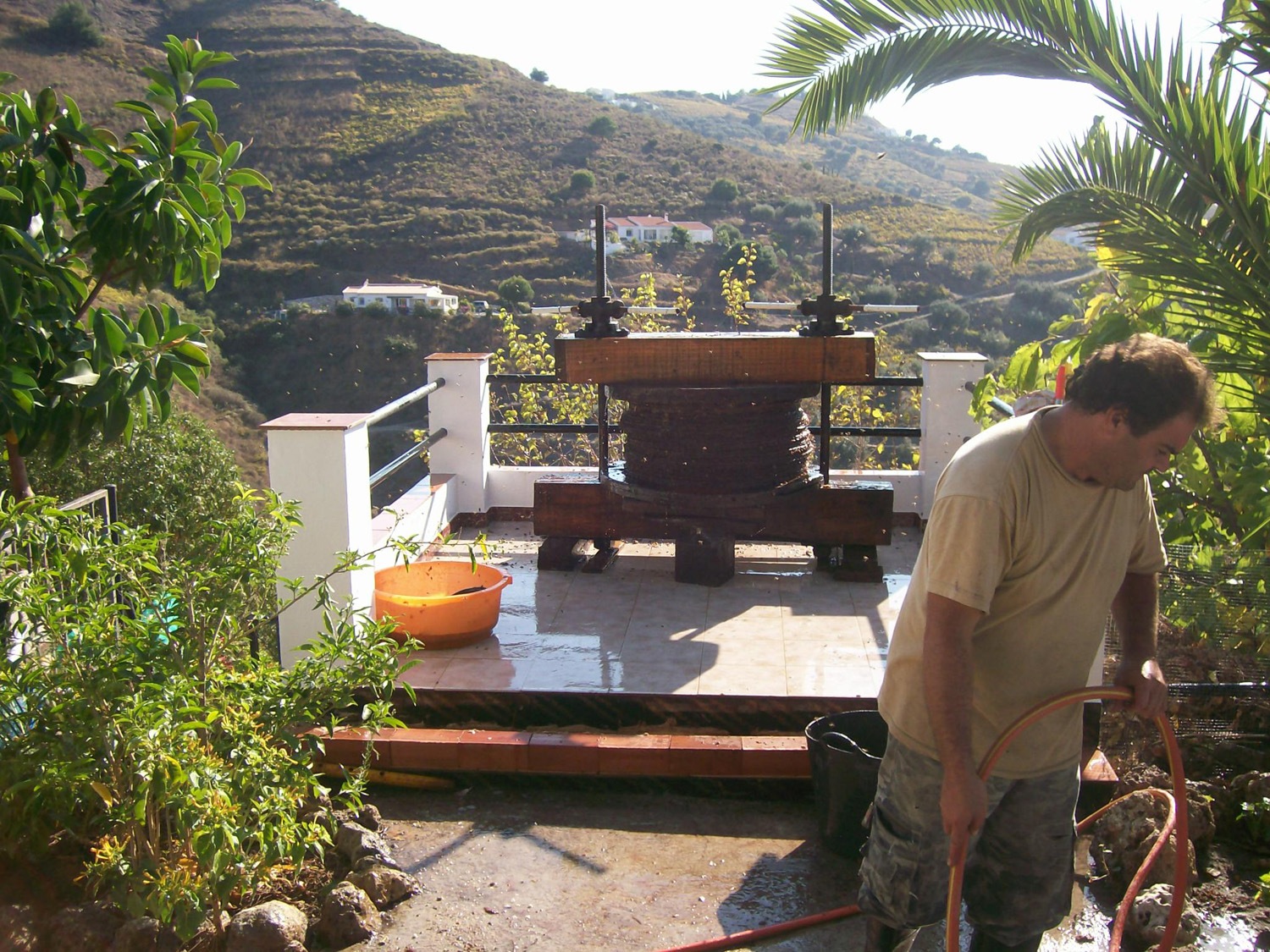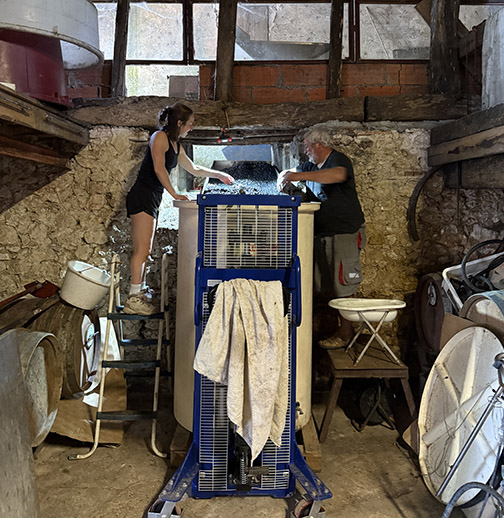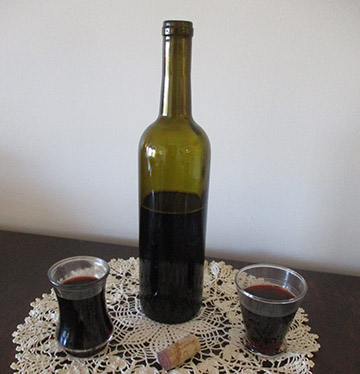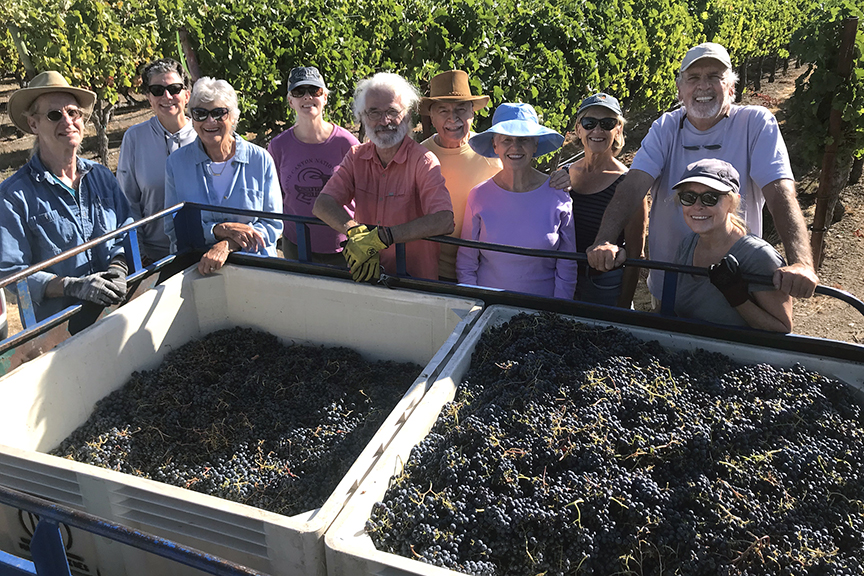
It’s been nine years now since I retired to warm, sunny southern Spain. My Spanish wife, Aurora, and I live in the mountains above the Costa del Sol looking down to the Mediterranean Sea in a small white Andalucian village called Cómpeta; a town rich in tradition and culture dating back to the Roman times.
Having run a facility called Wine Makers Cellar in Onset, Massachusetts and enjoyed home winemaking, I was looking forward to making wines in Spain. I soon learned that Cómpeta is well known along the coast for its Muscat wines. Soon after moving here, I visited Museum del Vino, which actually is not a museum but a bar/resturant/gift shop with barrels of Muscat wine and decorated with a wine waterfall. I’m used to sweet Muscat dessert wine so I was surprised to find barrels labeled saco (dry), semi-seco (semi-dry), semi-dulce (semi-sweet) and, of course, dulce (sweet). I asked if I could taste them and was served a small glass of wine from each barrel. By the time I had my second glass of wine I was almost drunk. I asked if they didn’t have wine tastings and they replied, “No, we just drink it.”
I got to meet several of the old-timers who have been making wine all their lives. The culture of winemaking goes back centuries so I was curious how they made it. The explanation I was given was way over my head with my limited Spanish but finger pointing worked wonders. I went out to their “finca” (a country place where they spend their weekends) and was shown the steep hills where the mountain goats fear to tread. There are about 600 acres of wine grapes in Cómpeta and more grapes to be dried for raisins. Then I visited their “bodega” where they press and ferment their wine. I was astonished because I couldn’t see how they could make decent wine with their technique. It went against everything I learned about good winemaking. What was most interesting was the press they used — the grapes are placed between woven shallow baskets (“capachoes”) and stacked in the press where the must spills onto the floor to gutters that lead down to the barrels for fermentation. They use American oak barrels that have been used for over 8 years so there is no oak taste. Locals are very proud of the wines they make so I am very careful what I say about them. Most of the winemakers have a special barrel they care for and add to each year as it is depleted. To be invited into the back area for sampling their precious wine was indeed an honor.
Most people in this area know little about different grape varietals, especially those from other countries, and almost nothing about pairing wines with food. Four years ago I started a wine competition for the local winemakers with the goal of rating all the wines and identifying which wine was theirs. I only pour 0.5 oz. (15 mL) of each and the winemakers see, smell and taste each wine they judge. The tastings (“cata”) are becoming very popular but I am eliminating the competition. No one wants to know their wine is second best in a small town. I am also including various delicious Spanish foods into the tasting to expand the concept of selecting wines that pair well with different foods and introducing them to concentrates, not just grapes. There is a lot of resistance, but the idea of making wine year-round is very tantalizing. The idea of blending and adding flavors to a wine is foreign to them and it is fun to watch their faces when I say, “You can put the wine into oak or you can put the oak into wine.” My hope is to blend the traditional techniques of making wine as their forbearers did, while adding the enjoyment of creating new experiences.
 It’s been nine years now since I retired to warm, sunny southern Spain. My Spanish wife, Aurora, and I live in the mountains above the Costa del Sol looking down to the Mediterranean Sea in a small white Andalucian village called Cómpeta; a town rich in tradition and culture dating back to the Roman times.
Having run a facility called Wine Makers Cellar in Onset, Massachusetts and enjoyed home winemaking, I was looking forward to making wines in Spain. I soon learned that Cómpeta is well known along the coast for its Muscat wines. Soon after moving here, I visited Museum del Vino, which actually is not a museum but a bar/resturant/gift shop with barrels of Muscat wine and decorated with a wine waterfall. I’m used to sweet Muscat dessert wine so I was surprised to find barrels labeled saco (dry), semi-seco (semi-dry), semi-dulce (semi-sweet) and, of course, dulce (sweet). I asked if I could taste them and was served a small glass of wine from each barrel. By the time I had my second glass of wine I was almost drunk. I asked if they didn’t have wine tastings and they replied, “No, we just drink it.”
I got to meet several of the old-timers who have been making wine all their lives. The culture of winemaking goes back centuries so I was curious how they made it. The explanation I was given was way over my head with my limited Spanish but finger pointing worked wonders. I went out to their “finca” (a country place where they spend their weekends) and was shown the steep hills where the mountain goats fear to tread. There are about 600 acres of wine grapes in Cómpeta and more grapes to be dried for raisins. Then I visited their “bodega” where they press and ferment their wine. I was astonished because I couldn’t see how they could make decent wine with their technique. It went against everything I learned about good winemaking. What was most interesting was the press they used — the grapes are placed between woven shallow baskets (“capachoes”) and stacked in the press where the must spills onto the floor to gutters that lead down to the barrels for fermentation. They use American oak barrels that have been used for over 8 years so there is no oak taste. Locals are very proud of the wines they make so I am very careful what I say about them. Most of the winemakers have a special barrel they care for and add to each year as it is depleted. To be invited into the back area for sampling their precious wine was indeed an honor.
Most people in this area know little about different grape varietals, especially those from other countries, and almost nothing about pairing wines with food. Four years ago I started a wine competition for the local winemakers with the goal of rating all the wines and identifying which wine was theirs. I only pour 0.5 oz. (15 mL) of each and the winemakers see, smell and taste each wine they judge. The tastings (“cata”) are becoming very popular but I am eliminating the competition. No one wants to know their wine is second best in a small town. I am also including various delicious Spanish foods into the tasting to expand the concept of selecting wines that pair well with different foods and introducing them to concentrates, not just grapes. There is a lot of resistance, but the idea of making wine year-round is very tantalizing. The idea of blending and adding flavors to a wine is foreign to them and it is fun to watch their faces when I say, “You can put the wine into oak or you can put the oak into wine.” My hope is to blend the traditional techniques of making wine as their forbearers did, while adding the enjoyment of creating new experiences.
It’s been nine years now since I retired to warm, sunny southern Spain. My Spanish wife, Aurora, and I live in the mountains above the Costa del Sol looking down to the Mediterranean Sea in a small white Andalucian village called Cómpeta; a town rich in tradition and culture dating back to the Roman times.
Having run a facility called Wine Makers Cellar in Onset, Massachusetts and enjoyed home winemaking, I was looking forward to making wines in Spain. I soon learned that Cómpeta is well known along the coast for its Muscat wines. Soon after moving here, I visited Museum del Vino, which actually is not a museum but a bar/resturant/gift shop with barrels of Muscat wine and decorated with a wine waterfall. I’m used to sweet Muscat dessert wine so I was surprised to find barrels labeled saco (dry), semi-seco (semi-dry), semi-dulce (semi-sweet) and, of course, dulce (sweet). I asked if I could taste them and was served a small glass of wine from each barrel. By the time I had my second glass of wine I was almost drunk. I asked if they didn’t have wine tastings and they replied, “No, we just drink it.”
I got to meet several of the old-timers who have been making wine all their lives. The culture of winemaking goes back centuries so I was curious how they made it. The explanation I was given was way over my head with my limited Spanish but finger pointing worked wonders. I went out to their “finca” (a country place where they spend their weekends) and was shown the steep hills where the mountain goats fear to tread. There are about 600 acres of wine grapes in Cómpeta and more grapes to be dried for raisins. Then I visited their “bodega” where they press and ferment their wine. I was astonished because I couldn’t see how they could make decent wine with their technique. It went against everything I learned about good winemaking. What was most interesting was the press they used — the grapes are placed between woven shallow baskets (“capachoes”) and stacked in the press where the must spills onto the floor to gutters that lead down to the barrels for fermentation. They use American oak barrels that have been used for over 8 years so there is no oak taste. Locals are very proud of the wines they make so I am very careful what I say about them. Most of the winemakers have a special barrel they care for and add to each year as it is depleted. To be invited into the back area for sampling their precious wine was indeed an honor.
Most people in this area know little about different grape varietals, especially those from other countries, and almost nothing about pairing wines with food. Four years ago I started a wine competition for the local winemakers with the goal of rating all the wines and identifying which wine was theirs. I only pour 0.5 oz. (15 mL) of each and the winemakers see, smell and taste each wine they judge. The tastings (“cata”) are becoming very popular but I am eliminating the competition. No one wants to know their wine is second best in a small town. I am also including various delicious Spanish foods into the tasting to expand the concept of selecting wines that pair well with different foods and introducing them to concentrates, not just grapes. There is a lot of resistance, but the idea of making wine year-round is very tantalizing. The idea of blending and adding flavors to a wine is foreign to them and it is fun to watch their faces when I say, “You can put the wine into oak or you can put the oak into wine.” My hope is to blend the traditional techniques of making wine as their forbearers did, while adding the enjoyment of creating new experiences.



